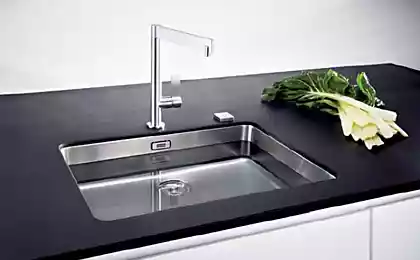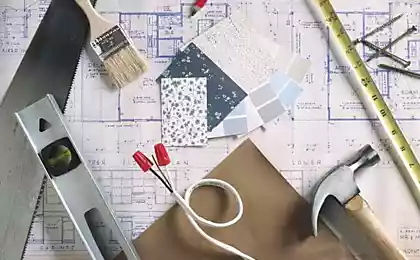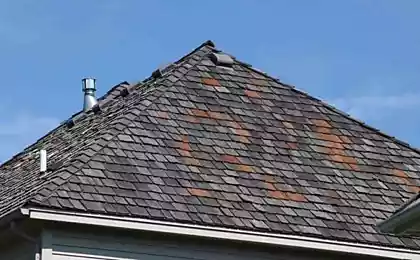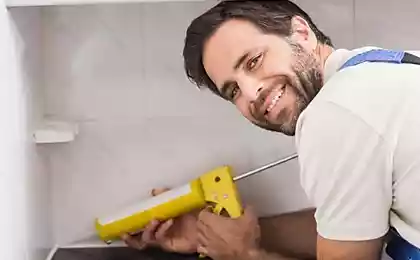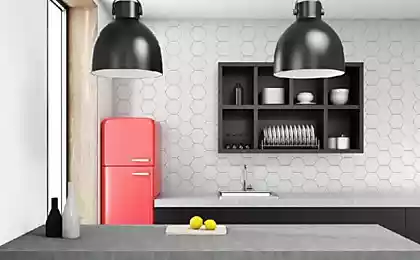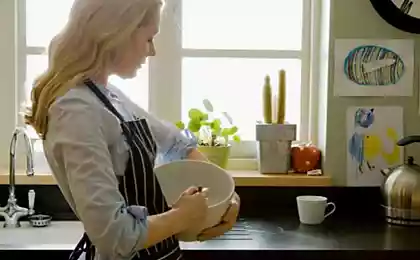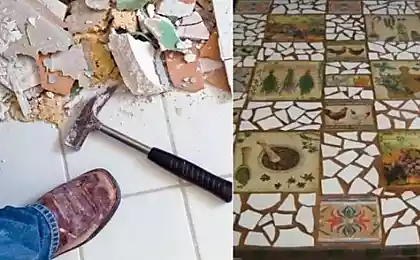987
How is the ceramic tile
Pyzhitsya will long be notified at the end of
It will focus on the production of ceramic tiles factory Lasselsberger Ceramics.
In 2006 the company started construction of a factory in Russia for the production of ceramic tiles and in early 2009 the launch of the first production line.
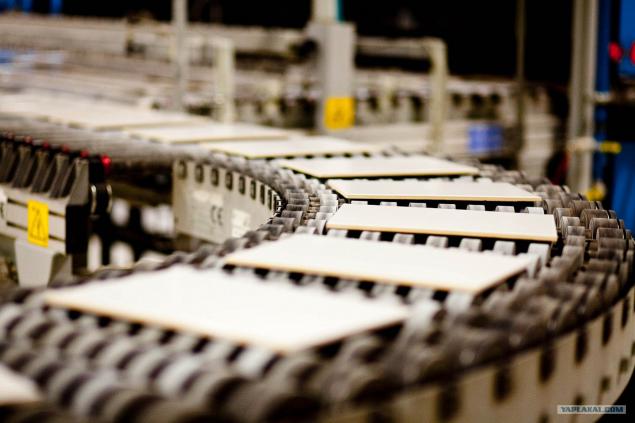
Delivery of raw materials. The plant can simultaneously accommodate up to 6 cars. Starting materials: clay materials, quartz materials feldshpatovye and / or carbonaceous materials.

Simultaneous storage of six different types of raw materials

Equipment for loading raw materials onto a conveyor

Automatic dosing of raw materials with the help of electronic scales

Mixture is in several operations. Specially prepared mixture consisting of different kinds of clay with the addition of other natural components, mixed in special drums and simultaneously humidified. Then dried and ground into a huge vertical silos almost to a state of slurry. The process involves three basic steps: mixing and hydration

Grinding

Drying
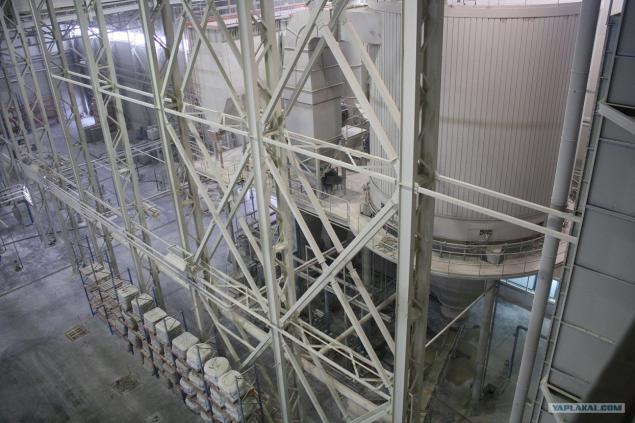
During extrusion the mass of powder with a moisture content of 7-10% is compressed in two directions, typically under a pressure of 200-400 kg / cm2. Due to this, even unfired tile has an appropriate density and strength.

10

11

Drying
In the drying step removes water from the product. The drying conditions are essential to ensure the integrity of the product, so the process should be carefully monitored in order to avoid deformation, cracks and other defects. Dryers provides an outlet moisture on the surface of the product and its further evaporation and removal. Performance setting provides good heat transfer, effective ventilation and relatively high temperatures at which the dehumidification is performed.

13

Glaze
Glaze is a mixture of various compounds and minerals (frit, kaolin, sand, various oxides, pigments, which are applied to the surface of the article and melt). Upon subsequent cooling the molten mass solidifies to form a glass, which gives the top layer of tiles special properties. Preparation glaze is dispensing different materials and grinding in water. This gives a suspension with a water content of 40-50%, ready for use. The glaze may be applied to the dried surface. The process of applying the glaze is very important, so it is included in the fully automated line, which also includes machines for applying ornament.

15

Before firing the tiles are going into storage
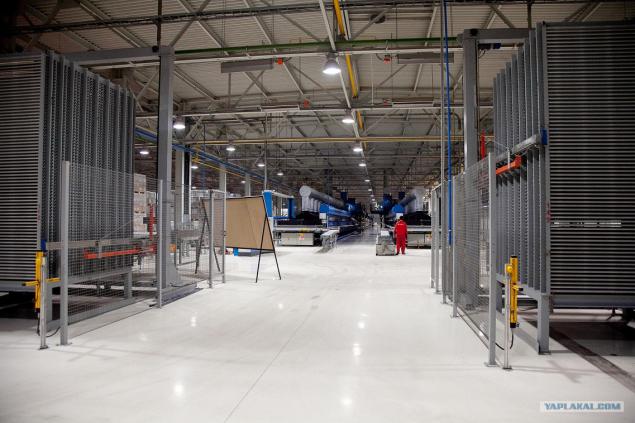
Firing
By firing tiles, as well as other ceramics acquires mechanical characteristics that make it suitable for various uses and properties of chemical inertness. These characteristics are the result of chemical reactions and physical changes which occur both in the tile, and a glaze (in the case of glazed tiles). Calcination is carried out in continuous furnaces, which are tunnel that tile is moved by special conveyors, being subjected to first preheated, and then heated to the firing temperature, which, depending on the type of product could be from 900 to 1250 ° C and a.
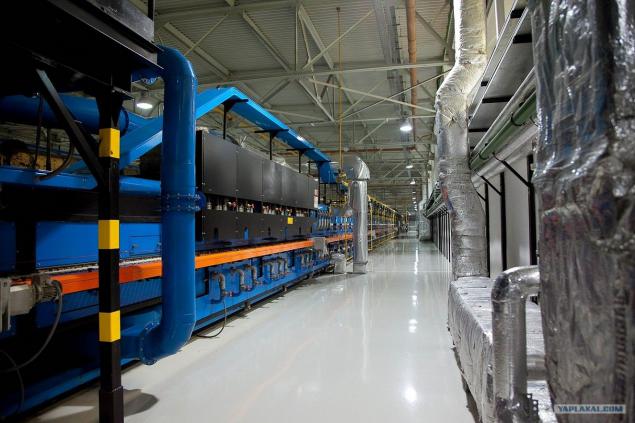
Atskaya heat

And again the drive.

After exiting tiles from the oven, it enters the special storage for the finished product. In one storage tile is the same size and same series. The automated system has used a special technique of "robotic transporters" for the carriage drives. At the right time to the robots transported drives the conveyor belt for sorting.

Koresh terminator

Sort
For quality control sorting line installed flaw to verify the geometric parameters of ceramic tiles. Conveyor speed - 2 tiles per second
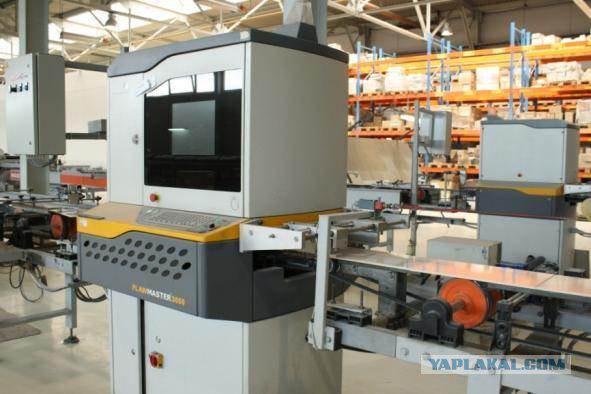
Packing
The packing process is automated, a special robot packer, the signal system, packs a ceramic tile in the right boxes, divided into first grade and commercial grade. The system recognizes the variety, type, and generates a collection of tiles pallets.
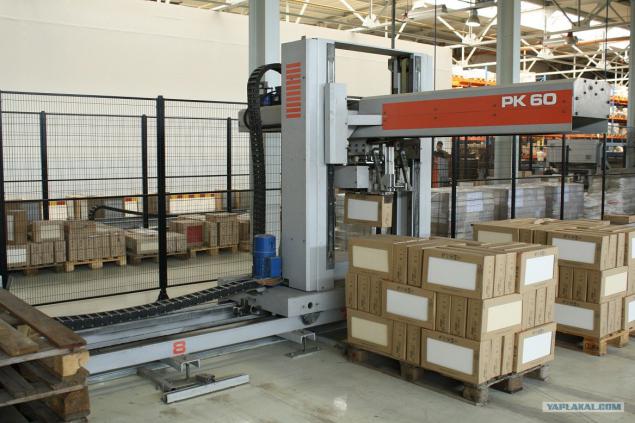
24

Packing
After forming, the pallet enters the packing. Special packaging machine (Palletizers) pulls pallet ribbons and wraps film.

26

Further, warehouse or line of "third firing" Stations painting allow to put a few flowers on the tiles, creating a unique pattern and relief, in a single pass through. Coloring pigments sequentially applied to the surface of the previously burnt tiles, ie for the production of decorative elements used ready-made "basic" tiles. Further, in a small furnace, the effect of temperature on the glaze melts and shows a unique pattern.

All the decorative elements of the future designs are developed individually, taking into account the specificity of raw materials and the "base" of the tile.

And now just to the warehouse and then to customers.
I have all

Source:
It will focus on the production of ceramic tiles factory Lasselsberger Ceramics.
In 2006 the company started construction of a factory in Russia for the production of ceramic tiles and in early 2009 the launch of the first production line.

Delivery of raw materials. The plant can simultaneously accommodate up to 6 cars. Starting materials: clay materials, quartz materials feldshpatovye and / or carbonaceous materials.

Simultaneous storage of six different types of raw materials

Equipment for loading raw materials onto a conveyor

Automatic dosing of raw materials with the help of electronic scales

Mixture is in several operations. Specially prepared mixture consisting of different kinds of clay with the addition of other natural components, mixed in special drums and simultaneously humidified. Then dried and ground into a huge vertical silos almost to a state of slurry. The process involves three basic steps: mixing and hydration

Grinding

Drying

During extrusion the mass of powder with a moisture content of 7-10% is compressed in two directions, typically under a pressure of 200-400 kg / cm2. Due to this, even unfired tile has an appropriate density and strength.

10

11

Drying
In the drying step removes water from the product. The drying conditions are essential to ensure the integrity of the product, so the process should be carefully monitored in order to avoid deformation, cracks and other defects. Dryers provides an outlet moisture on the surface of the product and its further evaporation and removal. Performance setting provides good heat transfer, effective ventilation and relatively high temperatures at which the dehumidification is performed.

13

Glaze
Glaze is a mixture of various compounds and minerals (frit, kaolin, sand, various oxides, pigments, which are applied to the surface of the article and melt). Upon subsequent cooling the molten mass solidifies to form a glass, which gives the top layer of tiles special properties. Preparation glaze is dispensing different materials and grinding in water. This gives a suspension with a water content of 40-50%, ready for use. The glaze may be applied to the dried surface. The process of applying the glaze is very important, so it is included in the fully automated line, which also includes machines for applying ornament.

15

Before firing the tiles are going into storage

Firing
By firing tiles, as well as other ceramics acquires mechanical characteristics that make it suitable for various uses and properties of chemical inertness. These characteristics are the result of chemical reactions and physical changes which occur both in the tile, and a glaze (in the case of glazed tiles). Calcination is carried out in continuous furnaces, which are tunnel that tile is moved by special conveyors, being subjected to first preheated, and then heated to the firing temperature, which, depending on the type of product could be from 900 to 1250 ° C and a.

Atskaya heat

And again the drive.

After exiting tiles from the oven, it enters the special storage for the finished product. In one storage tile is the same size and same series. The automated system has used a special technique of "robotic transporters" for the carriage drives. At the right time to the robots transported drives the conveyor belt for sorting.

Koresh terminator

Sort
For quality control sorting line installed flaw to verify the geometric parameters of ceramic tiles. Conveyor speed - 2 tiles per second

Packing
The packing process is automated, a special robot packer, the signal system, packs a ceramic tile in the right boxes, divided into first grade and commercial grade. The system recognizes the variety, type, and generates a collection of tiles pallets.

24

Packing
After forming, the pallet enters the packing. Special packaging machine (Palletizers) pulls pallet ribbons and wraps film.

26

Further, warehouse or line of "third firing" Stations painting allow to put a few flowers on the tiles, creating a unique pattern and relief, in a single pass through. Coloring pigments sequentially applied to the surface of the previously burnt tiles, ie for the production of decorative elements used ready-made "basic" tiles. Further, in a small furnace, the effect of temperature on the glaze melts and shows a unique pattern.

All the decorative elements of the future designs are developed individually, taking into account the specificity of raw materials and the "base" of the tile.

And now just to the warehouse and then to customers.
I have all

Source:


